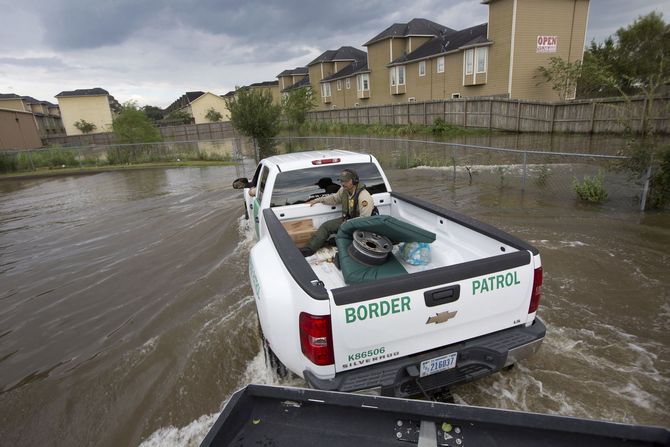by Aine Moriarty and Bruna Araujo
To help people affected by the Hurricane Harvey go to
https://www.redcross.org/donate/hurricane-harvey and make a donation.
To help people affected by Hurricane Irma go to
https://www.redcross.org/donate/hurricane-irma-donations.
Hurricane Harvey caused disastrous impacts in areas of Texas and Louisiana.
On August 25, Harvey hit the Texas Gulf Coast as a Category 4 hurricane, with winds topping at 130 mph. By August 30, it reached southwestern Louisiana as a tropical storm.

Environmental Impacts
According to the Texas Department of Public Safety, the death toll from the storm and flooding is 60, with more than 185,000 homes were damaged and 9,000 destroyed.
In under five days, it was registered at 51.88 inches of rain in areas from Houston, Texas into Louisiana. Officials worry that flooding carries health and environmental risks. “There’s no need to test it,” stated Porfirio Villarreal, from the Houston Health Department, “It’s contaminated. There’s millions of contaminants.”
On top of that, on August 31, the flooding caused the Arkema chemical plant near Houston to explode twice. 15 police officers were taken to the hospital for inhaling fumes and an evacuation zone of 1.5 miles around the plant remains in the area.
Economic Impacts
According to the Bureau of Safety and Environmental Enforcement, around 10% of manned oil platforms in the Gulf of Mexico were evacuated. As a result, gas prices have risen nationally by more than 17 cents.
Harvey is on its way to be one of the most costly natural disasters in the U.S. history. Flooding and storm damage in Texas and Louisiana is expected to cost more than $100 billion to clean up and repair.

Hurricane Irma
Hurricane Irma is the strongest hurricane to ever be recorded in the Atlantic Ocean, causing devastating impacts in the Caribbean Islands and southeastern areas of the U.S.
The hurricane was a Category 5 storm when it reached the Caribbean Islands on September 6 through September 8. On September 10, Irma reached Florida as a Category 4 storm, although it had been downgraded to Category 2 by the time it reached Orange County. It made its way up to Georgia as a tropical storm and weakened as it moved toward Tennessee.
Caribbean Islands
Irma left at least 37 people dead on its way through the Caribbean Islands. Many residents are still without electricity and running out of food, water and gas.
The Island of Barbuda is completely empty for the first time in 300 years. 95% of the buildings were damaged and the island “was literally underwater” and “barely habitable”, according to Prime Minister Gaston Browne. About 50% of the Barbuda population is now homeless and the death of a young child was recorded.
On the Dutch side of the island of St. Martin, two-thirds of the homes were left uninhabitable: no electricity, gas or drinking water, and four deaths were recorded. On the French side of the island, there will be a $1.4 billion cost in damage with nine deaths across St. Martin and St. Barts.
In the Virgin Islands, at least nine deaths were recorded. Widespread damage was reported on both sides of the islands.
At least three deaths occurred in Puerto Rico. The island was not directly hit by the hurricane, but the infrastructure was badly affected by it: more than half of the residents were without power.
In Cuba, ten deaths were recorded. Havana was the most affected, the hurricane stayed in the north of the island for several hours. Buildings were damaged and some destroyed. The island is also dealing with many floodings and power outage.
These were just some of the most impacted islands – others like Haiti, the Dominican Republic, Turks and Caicos, Anguilla and Tortola also experienced flooding, damaged houses and buildings, and power outages.
Southeastern U.S.
There were at least 31 recorded deaths related to the storm across the three states: Florida, South Carolina and Georgia.
In Florida, even days before the storm supermarkets were already running out of supplies. Supermarkets such as Publix, Walmart and Costco had barely any water on shelves due to the people’s preparation for the storm. Gas stations were also running out of gas due to evacuation of many Floridians.
After the storm finally reached the Florida Keys, 24 deaths in connection to the storm were recorded.
The storm also caused an extensive power outage in the area of Florida, the number of customers without power reached 6.5 million on September 11. It was also recorded extensive floodings, specially in the Keys.
According to FEMA, 90% of homes suffered some damage in the Florida Keys.
Four people died in South Carolina and three in Georgia, according to officials. Both states are struggling with heavy floodings and power outages in coastal areas.
On September 11,right after the storm, it was reported more than 900,000 power outages by Georgia Power. And in South Carolina, the South Carolina Electric & Gas Co. reported 154,000 outages on the day of the storm.
The damage cost less than expected in the U.S, but, in return, the Caribbean Islands are dealing with a lot more damage than it was expected originally.
We have a few student comments about their experiences during Hurricane Irma:
“My tree fell down.”– Ledellia R.
“My tree fell down and had no power for 3 days while my house filled with water.” – Adrianna Molina
“I lost power and it was very difficult but luckily I came up with a plan and I made it through.” – Elizabeth Dominguez
Sources:
Hurricane Harvey:
- http://abcnews.go.com/US/hurricane-harvey-wreaks-historic-devastation-numbers/story?id=49529063
- https://fivethirtyeight.com/features/hurricane-harveys-impact-and-how-it-compares-to-other-storms/
- http://www.businessinsider.com/tropical-storm-harvey-hurricane-updates-map-texas-where-landfall-damage-2017-8
- https://www.nytimes.com/2017/08/28/us/hurricane-harvey-texas.html?mcubz=3
- https://www.nytimes.com/2017/08/31/us/houston-contaminated-floodwaters.html?src=twr
- https://www.bsee.gov/newsroom/latest-news/statements-and-releases/press-releases/bsee-tropical-storm-harvey-activity-5
- http://www.businessinsider.com/why-chemical-plant-exploded-harvey-other-plants-risk-flooding-2017-8
- https://www.redcross.org/donate/hurricane-harvey
- http://go.galegroup.com/ps/retrieve.do?tabID=Images&resultListType=RESULT_LIST&searchResultsType=SingleTab&searchType=BasicSearchForm¤tPosition=6&docId=GALE%7CKFBUXP151521496
- http://abcnews.go.com/US/wireStory/death-toll-harvey-rises-60-49617198
Hurricane Irma:
